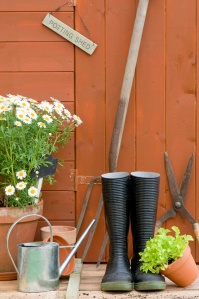By Leroy Houser
Gardening is one of the most thought-provoking activities I do. For the most part it’ssomething you can do alone, as most people don’t want to be involved in the digging, cutting and sweating. I grew up in a small town (Hopewell, VA), and every family on our street had a garden that included things to eat and things that bloomed. My Uncle Frank (Frank Parr) was the ultimate “Green Thumb,” and his vegetable garden was a work of art. He could grow anything and lots of it! Not only was he a great gardener but a wonderful person as well.
As an adult, my gardening experiences were enhanced by David Sauer and Bert Shoosmith, who were not only excellent horticulturist but were generous with their plants and wisdom. The influences from David, Bert and Frank got me started, and my gardens today contain plants and ideas I received from each of them years ago. The garden for me is a connector to the past and the present, so this blog is about many of the ideas I learned from them and others as well. Even though they are all deceased I see them in the garden every day. Real estate can be an all-consuming business, but a few minutes a day in a garden is a therapeutic experience that’s available 24/7.
7 Gardening Tips for Busy People
1. Pots are Tops. It is easier to grow things in pots than in dirt. You can control everything in pots: the water, the size, the critters (voles, squirrels, etc), the temperature, everything. We always test new plants in pots before we plant them to see where they will do the best. This process eliminates the trial and error process that is expensive in both time and money. Bigger pots are better because they hold more growing medium (Miracle-Gro) and water. Putting dirt in a pot is a recipe for disaster.
2. Three is Key. Wish I had learned this earlier. If you buy 3 plants or shrubs of a kind, it makes it easier to arrange them – and if you plant them close together, they look like one large, impressive plant. Also, if one dies, you still have two instead of an empty space.
3. Closer is Better. It has been much easier for me and better for the plants if they are planted closer together. They shade each other from the hot summer sun, thus halting some evaporation, and the plants as a group cover the dirt or mulch which is not the most appealing feature of any garden.
4. Drip hoses and timers. We usually have either too much water or not enough; it never seems to be just right (except in the pots). Drip hoses and inexpensive timers are worth the cost because one week without water stunts some plants to the point where they never recover. Two things most plants need are sunlight and water; after all, the simple stuff makes the garden grow! Drip hoses put the water where it is needed, and you can apply mulch over them to keep them from being unsightly.
5. Easy Mulch and Compost. The two mulches we have found to be the best are pine straw (Home Depot) and shredded leaves. A simple way to compost them is to collect the leaves in one of those large plastic bags, tie them up tight, and put them behind the garage and forget them for a year. They will decompose to form a wonderful addition to any soil. We put a shovel full of compost in every planting hole. Simple, easy and effective – just like working with a great salesperson!!!!
6. No Fertilizer/No Chemicals. Compost and bagged cow manure (organic) are all most plants need (with an occasional very light liquid fertilizer to get some plants started). Synthetic fertilizers are damaging to the micronutrients and worms and the chemicals are deadly for the birds and butterflies. The birds take care of the bugs and we take care of the birds. Good friends take good care of each other in the office or in the garden.
7. Easy Things to Grow. Some plants are easy and beautiful and some are difficult. I learned long ago to go the easy route. My time is too valuable to spend with plants that don’t want to grow right.
Here is my Easy and Beautiful list:
Knock Out Roses – easy as roses can be
- Zinnias from seed
- Day Lilies
- Tithonia – Mexican Sunflower from seeds
- Butterfly Bush
- Anything in a pot
- Dill, parsley, basil, chives – in pots
- Most perennials
- Pachysandra – ground cover
- Japanese maples – in a large pot for the first year
- Annuals – they die in a year anyway
- Lantana – an annual here
- Ferns
- Azaleas


